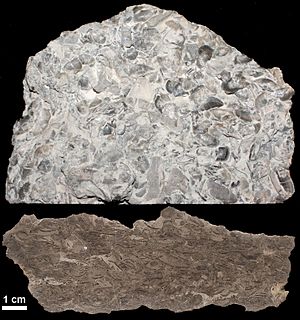Kope Formation facts for kids
Quick facts for kids Kope FormationStratigraphic range: Katian |
|
|---|---|

Photograph and etched section of hand sample of limestone of Kope Formation. Brachiopods and Bryozoans visible.
|
|
| Type | sedimentary |
| Unit of | Maquoketa Group (in Indiana) |
| Sub-units | Grand Avenue Member, Wesselman Tongue |
| Underlies | Dillsboro Formation and Fairview Formation |
| Overlies | Lexington Limestone, Plattin Formation, and Point Pleasant Formation |
| Lithology | |
| Primary | Shale |
| Other | Limestone |
| Location | |
| Region | Cincinnati Arch of North America |
| Extent | Kentucky, Ohio, Indiana |
The Kope Formation is one of three main rock layers that make up the Maquoketa Group. It is mostly made of shale (about 75%) with some layers of limestone (about 25%) mixed in.
This rock formation usually looks bluish-gray. When it's exposed to the weather, it turns light gray or yellowish-gray. You can find the Kope Formation in northern Kentucky, southwest Ohio, and southeast Indiana in the United States.
Contents
What is the Kope Formation?
How the Kope Formation Formed
The Kope Formation was created in a shallow sea. This means it formed in water that wasn't very deep. At that time, the middle part of North America was covered by a warm, shallow sea called an epeiric sea.
The Kope Formation, along with other rock layers like the Bellevue and Fairview Formations, formed as sediments built up on the sea floor. The Kope represents the parts of the sea floor that were farthest from the ancient shorelines.
Where to See the Kope Formation
You can find important examples of the Kope Formation in certain places. For instance, a key spot for the Grand Avenue Member is a cliff west of Grand Avenue in Cincinnati, Hamilton County, Ohio.
Another important location for the Wesselman Tongue of the Kope Formation is an embankment. This is on the east side of a creek that runs along Wesselman Road in Miami Township, Hamilton County, Ohio. This spot is about 400 feet (120 meters) south of the Zion Hill bridge.
Fossils Found in the Kope Formation
The Kope Formation is famous for its many fossils! You can find brachiopods, trilobites, bryozoans, rugose corals, and echinoderms. Echinoderms include creatures like crinoids (sea lilies), starfish, and edrioasteroids.
Because these fossils formed in the middle of a continent, they are usually in great shape. They haven't been squished or changed much by the powerful forces that created mountains, like the Appalachian Mountains.
Many types of brachiopods have been found in the Kope Formation. These include Dalmanella sp., Hebertella sp., Leptaena sp., Petrocrania sp., Philhedra sp., Platystrophia sp., Pseudolingula sp., Rafinesquina sp., Sowerbyella sp., Strophomena sp., Trematis sp., and Zygospira sp.
Some trilobites found here are Triarthrus eatoni, Cryptolithus tessellatus, and Proetidella parviusculus. The Ohio State Fossil, Isotelus maximus, is also likely to be found in the Kope Formation.
Bryozoans are also common. Examples include Ceramophylla sp., Eridotrypa mutabilis, Peronopera vera, Batostoma jamesi, Dekayia aspera, Heterotrypa ulrichi, Parvohallopora sp., and Amplexopora septosa.
Among the echinoderms, crinoids like Cincinnaticrinus varibrachialis, Ectenocrinus sp., and Iocrinus sp. are present. While usually rare, edrioasteroids and starfish are common in the rock layers above the Kope. They might also be found in the Kope Formation itself.
How Old is the Kope Formation?
The Kope Formation dates back to the Late Ordovician period. This means it is very, very old!


